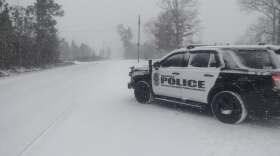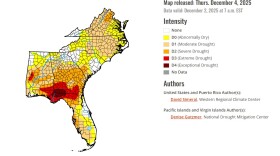Hurricane Tammy SD-1040-video_20231022_160056_2-Logo.mp4
Saildrone and NOAA released footage on Monday from Hurricane Tammy, captured near the western and southern eyewall of the storm.
During this storm, NOAA successfully conducted the first co-located mission into a hurricane that included a Saildrone USV and a low-flying aerial drone (Anduril’s Altius-600) deployed from a Hurricane Hunter P-3.
More on Saildrones
1 of 23
— In early March, two months before Falkor departed for the same mission, two saildrones were deployed from San Francisco. They have been transmitting data in real time, listening for the acoustic tags that researchers attached to great white sharks and using sonar to detect other creatures deep under the surface.
In early March, two months before Falkor departed for the same mission, two saildrones were deployed from San Francisco. They have been transmitting data in real time, listening for the acoustic tags that researchers attached to great white sharks and using sonar to detect other creatures deep under the surface.
SOI/Monika Naranjo Gonzalez
2 of 23
— A drone sailed into Hurricane Sam and sent back this image.
A drone sailed into Hurricane Sam and sent back this image.
Saildrone
3 of 23
— NOAA and Saildrone Inc. are piloting five specially designed saildrones in the Atlantic Ocean to gather data around the clock to help understand the physical processes of hurricanes.
NOAA and Saildrone Inc. are piloting five specially designed saildrones in the Atlantic Ocean to gather data around the clock to help understand the physical processes of hurricanes.
Saildrone
4 of 23
— Credit: Saildrone
Credit: Saildrone
5 of 23
— sd-1078_cam24_1663851420734-logos.jpg
Saildrone, Inc. and the National Oceanic and Atmospheric Administration have released video and still photos gathered by a Saildrone uncrewed surface vehicle from inside Hurricane Fiona, a Category 4 hurricane, barreling across the Atlantic Ocean.
Saildrone, Inc.
6 of 23
— 2022 Saildrone Atlantic hurricane operation areas.jpg
Map showing a rough outline of the operation areas during the 2022 Atlantic Hurricane mission. One saildrone will be assigned to each op area.
7 of 23
— 20230623_Atlantic Hurricane Deploy St Pete_0461.jpeg
Saildrone has launched 12 drones as part of a mission of ongoing research into how and why some relatively mild tropical storms rapidly intensify into major hurricanes, which is particularly destructive when it happens just before landfall. Of all recorded weather disasters in the US, hurricanes have had the most significant impact: Between 1980 and 2021, hurricanes were responsible for over $1.1 trillion total in damages and 6,697 deaths
Saildrone / Special to WGCU
8 of 23
— 2023 hurricane deployment and domain areas.jpg
Saildrone is launching 12 drones this storm season as part of a mission of ongoing research into how and why some relatively mild tropical storms rapidly intensify into major hurricanes, which is particularly destructive when it happens just before landfall. Of all recorded weather disasters in the US, hurricanes have had the most significant impact: Between 1980 and 2021, hurricanes were responsible for over $1.1 trillion total in damages and 6,697 deaths
Saildrone / Special to WGCU
9 of 23
— 20230522-AtlanticHurricaneDeploy-5128.jpg
Saildrone is launching 12 drones this storm season as part of a mission of ongoing research into how and why some relatively mild tropical storms rapidly intensify into major hurricanes, which is particularly destructive when it happens just before landfall. Of all recorded weather disasters in the US, hurricanes have had the most significant impact: Between 1980 and 2021, hurricanes were responsible for over $1.1 trillion total in damages and 6,697 deaths
Saildrone / Special to WGCU
10 of 23
— 20230522-AtlanticHurricaneDeploy-5290.jpg
Saildrone is launching 12 drones this storm season as part of a mission of ongoing research into how and why some relatively mild tropical storms rapidly intensify into major hurricanes, which is particularly destructive when it happens just before landfall. Of all recorded weather disasters in the US, hurricanes have had the most significant impact: Between 1980 and 2021, hurricanes were responsible for over $1.1 trillion total in damages and 6,697 deaths
Saildrone / Special to WGCU
11 of 23
— 20230608-Hurricane STVI Deploy-Sunset Tow.jpg
Saildrone is launching 12 drones this storm season as part of a mission of ongoing research into how and why some relatively mild tropical storms rapidly intensify into major hurricanes, which is particularly destructive when it happens just before landfall. Of all recorded weather disasters in the US, hurricanes have had the most significant impact: Between 1980 and 2021, hurricanes were responsible for over $1.1 trillion total in damages and 6,697 deaths
Saildrone / Special to WGCU
12 of 23
— 20230619_Hurricane STVI Deploy_7183.jpeg
Saildrone is launching 12 drones this storm season as part of a mission of ongoing research into how and why some relatively mild tropical storms rapidly intensify into major hurricanes, which is particularly destructive when it happens just before landfall. Of all recorded weather disasters in the US, hurricanes have had the most significant impact: Between 1980 and 2021, hurricanes were responsible for over $1.1 trillion total in damages and 6,697 deaths
Saildrone / Special to WGCU
13 of 23
— 20230622_Atlantic Hurricane Deploy St Pete_0364.jpeg
Saildrone is launching 12 drones this storm season as part of a mission of ongoing research into how and why some relatively mild tropical storms rapidly intensify into major hurricanes, which is particularly destructive when it happens just before landfall. Of all recorded weather disasters in the US, hurricanes have had the most significant impact: Between 1980 and 2021, hurricanes were responsible for over $1.1 trillion total in damages and 6,697 deaths
Saildrone / Special to WGCU
14 of 23
— 20230622_Atlantic Hurricane Deploy St Pete_0370.jpeg
Saildrone is launching 12 drones this storm season as part of a mission of ongoing research into how and why some relatively mild tropical storms rapidly intensify into major hurricanes, which is particularly destructive when it happens just before landfall. Of all recorded weather disasters in the US, hurricanes have had the most significant impact: Between 1980 and 2021, hurricanes were responsible for over $1.1 trillion total in damages and 6,697 deaths
Saildrone / Special to WGCU
15 of 23
— 20230622-Hurricane STVI deploy-3501.jpg
Saildrone is launching 12 drones this storm season as part of a mission of ongoing research into how and why some relatively mild tropical storms rapidly intensify into major hurricanes, which is particularly destructive when it happens just before landfall. Of all recorded weather disasters in the US, hurricanes have had the most significant impact: Between 1980 and 2021, hurricanes were responsible for over $1.1 trillion total in damages and 6,697 deaths
Saildrone / Special to WGCU
16 of 23
— 20230623_Atlantic Hurricane Deploy St Pete_0461.jpeg
Saildrone is launching 12 drones this storm season as part of a mission of ongoing research into how and why some relatively mild tropical storms rapidly intensify into major hurricanes, which is particularly destructive when it happens just before landfall. Of all recorded weather disasters in the US, hurricanes have had the most significant impact: Between 1980 and 2021, hurricanes were responsible for over $1.1 trillion total in damages and 6,697 deaths
Saildrone / Special to WGCU
17 of 23
— 20230623_Atlantic Hurricane Deploy St Pete_0474.jpeg
Saildrone is launching 12 drones this storm season as part of a mission of ongoing research into how and why some relatively mild tropical storms rapidly intensify into major hurricanes, which is particularly destructive when it happens just before landfall. Of all recorded weather disasters in the US, hurricanes have had the most significant impact: Between 1980 and 2021, hurricanes were responsible for over $1.1 trillion total in damages and 6,697 deaths
Saildrone / Special to WGCU
18 of 23
— 20230624_Atlantic Hurricane Deploy St Pete_0495.jpeg
Saildrone is launching 12 drones this storm season as part of a mission of ongoing research into how and why some relatively mild tropical storms rapidly intensify into major hurricanes, which is particularly destructive when it happens just before landfall. Of all recorded weather disasters in the US, hurricanes have had the most significant impact: Between 1980 and 2021, hurricanes were responsible for over $1.1 trillion total in damages and 6,697 deaths
Saildrone / Special to WGCU
19 of 23
— 20230624_Atlantic Hurricane Deploy St Pete_0501.jpeg
Saildrone is launching 12 drones this storm season as part of a mission of ongoing research into how and why some relatively mild tropical storms rapidly intensify into major hurricanes, which is particularly destructive when it happens just before landfall. Of all recorded weather disasters in the US, hurricanes have had the most significant impact: Between 1980 and 2021, hurricanes were responsible for over $1.1 trillion total in damages and 6,697 deaths
Saildrone / Special to WGCU
20 of 23
— 20230627_Hurricane Kickoff_1996.jpeg
Saildrone is launching 12 drones this storm season as part of a mission of ongoing research into how and why some relatively mild tropical storms rapidly intensify into major hurricanes, which is particularly destructive when it happens just before landfall. Of all recorded weather disasters in the US, hurricanes have had the most significant impact: Between 1980 and 2021, hurricanes were responsible for over $1.1 trillion total in damages and 6,697 deaths
Saildrone / Special to WGCU
21 of 23
— 20230627_Hurricane Kickoff_2011.jpeg
Saildrone is launching 12 drones this storm season as part of a mission of ongoing research into how and why some relatively mild tropical storms rapidly intensify into major hurricanes, which is particularly destructive when it happens just before landfall. Of all recorded weather disasters in the US, hurricanes have had the most significant impact: Between 1980 and 2021, hurricanes were responsible for over $1.1 trillion total in damages and 6,697 deaths
Saildrone / Special to WGCU
22 of 23
— hurricane saildrone config-final-simplified-logo.jpg
Saildrone is launching 12 drones this storm season as part of a mission of ongoing research into how and why some relatively mild tropical storms rapidly intensify into major hurricanes, which is particularly destructive when it happens just before landfall. Of all recorded weather disasters in the US, hurricanes have had the most significant impact: Between 1980 and 2021, hurricanes were responsible for over $1.1 trillion total in damages and 6,697 deaths
Saildrone / Special to WGCU
23 of 23
— SD 1045.jpg
Jenn Virskus for Saildrone
The Altius-600 is an uncrewed aircraft system (UAS) deployed from a NOAA Hurricane Hunter aircraft and capable of operating in low- and medium-altitude maritime environments. Typically flying below 5,000 ft, the Altius-600 collects data to better detect changes in the storm’s overall structure.
The saildrone is a solar-powered uncrewed surface vehicle (US) that provides data at and below the ocean surface. This data is used to improve the understanding and prediction of tropical cyclone intensity changes.
Together, the saildrone and Altius-600 bridged the gap from satellites and aircraft to the sea surface. They allowed the collection of data nopt obtainable any other way, from the boundary layer where crewed planes and boats cannot go safely, advancing the understanding of difficult-to-predict phenomena such as Rapid Intensification.
This historic collaboration required incredible coordination and signifies a giant leap forward in the mission to advance knowledge of ocean-atmosphere interactions in tropical cyclones. NOAA said it hopes to continue making progress so this kind of data collection is routine in future hurricane seasons.
WGCU is your trusted source for news and information in Southwest Florida. We are a nonprofit public service, and your support is more critical than ever. Keep public media strong and donate now. Thank you.






























